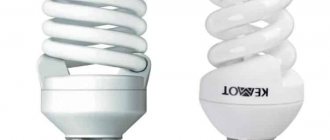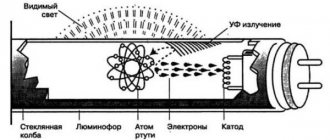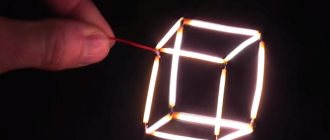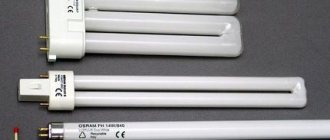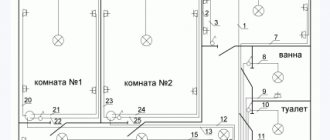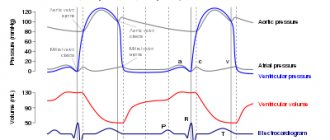Electrician in the house
Encyclopedia about electricity from A to Z
Masters catalog
Find the best master or company in your city
LED lighting in the apartment
Today, the reader and I will have to get acquainted with LED light sources and decide which lighting in the apartment is better - LED, fluorescent or traditional, using incandescent and halogen lamps. In addition, we will get acquainted with the types of LED lamps and learn how to calculate the lighting power depending on the purpose of the room. Let's get started.
- Why LEDs Advantages
- Flaws
What is LED lighting
Diode lighting is a method of supplying artificial light using energy-saving LED lamps. The technology has become widespread relatively recently, but has already earned recognition from interior designers.
With the help of LED devices it is easy to implement any lighting scenarios. The devices look attractive in the interior and are perfectly combined with the smart home system.
You can insert LED lamps into conventional lighting fixtures or immediately purchase LED devices. However, before choosing products, it is important to understand how they function.
Example of LED lighting in an apartment
Lighting calculation
How to calculate LED lighting for an apartment or private house with your own hands?
Luminosity is always indicated by the manufacturer on the packaging of the lamp or luminaire. If for some reason this is not done, a simple instruction will help you roughly estimate the luminosity: multiply the declared electrical power by 100. For example, a modern 10-watt LED lamp has a luminosity of 10x100 = 1000 lumens.
Luminosity is always indicated by the manufacturer on the packaging
To assess the need for light, it is enough to refer to the regulatory documentation. Lighting standards for residential and auxiliary premises are given in SNiP 05/23/2010.
For the convenience of the reader, we present here an excerpt from this document:
| Image | Room and illumination standard, lux |
| Living room in an apartment, hotel or dormitory, kitchen or dining room - 150 |
| Children's room - 200 |
| Library or office - 300 |
| Corridor between rooms, hallway, hall - 50 |
| Pantry, utility room – 300 |
| Dressing room – 75 |
| Bath, sauna, swimming pool, locker room - 100 |
| Gym – 150 |
| Bathroom, toilet, combined toilet – 50 |
| Stairs - 20 |
| Basement, attic - 20 |
Help: the unit of illumination - lux - corresponds to the illumination of a square meter by a light source with a luminosity of one lumen. For example, a living room with an area of 20 m2 should have a total lighting luminosity of 20x150 = 3000 lumens.
Relationship between luminosity and illumination units
Design and principle of operation of LEDs
LEDs are devices created on the basis of semiconductor elements with an electron-hole junction. Devices emit light only when electric current passes through them.
One of the semiconductors is dominated by positive ions, the other by electrons. When a current passes through the point of their contact, recombination of elements occurs. As a result, excess energy appears, which is converted into light radiation.
Diodes emit rays in the green, blue and red spectrum. As a result of mixing these tones, a white glow is obtained. Depending on the type of lamp, the flows can be either warm or cold.
Standard LED lamp design:
- A board with diodes located on it.
- Radiator.
- Driver.
- Diffuser.
- Base.
- Flask of any shape.
- Lower and upper holders.
The most important element of the system is the driver, which is located in the base of the device. It is a combination of a transformer, capacitors and microcircuits. The cost of LED lighting sources depends on the quality of this part. The driver is used to convert alternating current into direct current and stabilize the incoming voltage. Another function is powering the LEDs.
The socket is a necessary element for connecting the lamp to the lamp socket. There are several types of parts, but the most common are pin and screw.
The radiator serves to remove heat from the LED crystals. The larger the part, the better the effect of its work.
The diffuser plays an important role in the system. It helps to evenly distribute light fluxes and protects the lamp body from moisture and dust.
Colored LEDs
Round LED lamp
Characteristics
The main characteristics of emitting diodes include:
- operating current – the current value at which the lamp operates stably;
- voltage - the power that is needed for the device to operate;
- power is an important indicator that is needed when choosing a power supply;
- color temperature - the shade of the glow, it can be warm, neutral and cold;
- luminous flux - amount of light per 1 sq.m.;
- scattering angle – determines the area to which the lighting will be directed.
The characteristics also include crystal size.
Calculation of required brightness
Before buying lamps, determine what brightness you will need. This parameter should take into account the area of the room, its purpose, what function the lamps will perform. According to the standards for 1 sq.m. the living room should have 300-400 Lux of light, for the kitchen and bedroom about 250 Lux, for the hallway 100 Lux.
Light control
You can control the brightness of the lighting in various ways. These include:
- changing the number of diodes;
- change in current flowing through diodes;
- using the power regulator.
You can purchase a lamp with a dimmer. With its help you can adjust the brightness of the backlight.
LED lamps: pros and cons
To make a decision in favor of LED lighting, it is important to study the merits of light sources. Main advantages:
- Long service life: LED lamps can last up to 50,000 hours.
- Environmental friendliness and safety: no toxic components are used in the manufacture of lamps.
- Economical energy consumption: diode lamps require much less electricity than other lamps, but at the same time provide optimal illumination intensity.
- Housing strength: LED lamps will not break if accidentally dropped from a small height.
- Excellent light output parameters. The average luminous flux power is 50-100 Lm per 1 W.
- Optimal light spectrum: LEDs provide comfortable lighting similar to sunlight. For comparison: the color rendering index of natural streams is 100 units, LED lamps are 80-85.
LED lighting lamps are suitable for any room, including those with high humidity. The devices do not require maintenance or additional protection measures.
Important! The service life of devices does not depend on the frequency of switching off and switching on.
The disadvantages of LED lamps are much more difficult to identify. You can name one - relatively high cost. However, the disadvantage is compensated by reduced electricity consumption.
LED lamps in the interior of the apartment
Tape laying
Existing methods of its installation are optimal for performing different tasks and show different results. When installing the device, do not break, bend or twist the substrate, protecting it from damage to current-carrying connections.
Attaching tape to furniture in the room. Illumination of cabinets, niches, aesthetically impressive areas. The tape is placed inside objects and interiors. It is necessary to clean and degrease the surface, and then firmly attach it. Don’t forget about heat dissipation, since the heaters also heat up,
Installation in wall and ceiling niches. When installing the SDL on a plasterboard surface, it is first puttied, leveled, and covered with one layer of primer. The location of the converter and controller does not impair heat dissipation and allows free access for their inspection and repair. Additionally, the sides are strengthened, dissipating the flow of light that blinds the eyes. The LED strip is installed after all plasterboard boards are finally secured with screws. Otherwise, they may damage the tape or cause a short circuit.
Installation of LED strip indoors. It can be mounted on polyurethane baseboards or at any height (zone) of the room, first in a grease-free place. The device is in a special box. Low mechanical strength requires mounting it in aluminum profiles with an external light filter. They protect against mechanical damage, twisting, ruptures, dust and partially moisture. Before fixing the profile, plan and highlight the line of its placement on the plane. Once secured, the SDL is glued inside. It is quite safe to install such a device close to the floor.
Application of LEDs: types of lighting
Due to their excellent performance parameters, LED lamps are suitable for use indoors and outdoors. Types of lighting:
- Apartment.
- Office.
- Trade.
- Industrial.
- Street.
- Spotlight.
- Emergency.
LED lighting is especially often installed in living rooms. Diode lamps can be present in any lamps: wall, ceiling, decorative. You can also use LED strips. They are good for illuminating interior items, furniture, multi-level ceilings, niches, and stairs.
Apartment lighting with LED lamps
Adjusting the emission of the LED strip
The brightness and color of the LED strip are adjusted by a controller that changes the radiation flux separately for each color. The required mode is set by the remote control (RC). Which can be push-button, touch, infrared or radio. The latter can “command” one controller or an entire group. Motion sensors connect lights and lighting. For monochrome, a voltage converter is sufficient. Switches and breakers are located locally. It is advisable to secure the power source of the tape near its beginning or end.
Glow Orientation
Based on the inclination of the flow, LED strips are divided into 2 groups: side and front radiation. In the second, it is directed perpendicular to the surface of the base. Used for illumination of advertising, interior, car. In the first, the flow propagates parallel to the plane on which the elements are fixed. They are installed in the openings of advertising structures, highlighting information along the contour.
Emission color of LED lamps
LED lamps can have different shades of light. To determine the parameters, there is a color range, the main indicators of which are indicated in the table.
Color temperature indicators
| Warm white | Natural white | Cold white |
| 2700-3000 K | 4000-4500K | 6000-6500 K |
The higher the color temperature, the brighter the light from the lamp. A cold glow with a blue tint may not seem very comfortable for lighting an apartment. Therefore, natural white is ideal for home lamps.
Advice! To illuminate the bedroom, you can choose warm glow lamps.
Shades of LED lamps
Basic moments
The attractiveness of LED lamps is obvious - the lighting creates a pleasant atmosphere; you can use single-color, colored LEDs, or combine different light sources. The use of LEDs in an apartment allows you to realize design ideas, give rooms an original look, and visually emphasize the advantages of the style.
Lighting using LEDs allows you to decorate walls, ceilings, floors, and highlight any functional area of the room. The products are easy to install, easily attached to the base surface, and you can install them yourself.
An important feature of LEDs is that the devices do not heat the surfaces they come into contact with or are in close proximity to, which eliminates the risk of fire.
Advantages and disadvantages of ice lamps
LED lighting devices appeared on the market relatively recently and quickly gained popularity among consumers. According to reviews, they have important advantages:
- Low energy consumption - a diode device at full power uses 70% less electricity than conventional light bulbs.
- Long service life - with proper calculation and development of the power supply circuit, the lighting operates for about one hundred thousand hours.
- High degree of resistance to damage - the devices are made of durable materials and do not have incandescent elements.
- No flickering effect – when using LED lamps, the voltage on the organs of vision is reduced.
- Minimal heating and heat release - thanks to low heat transfer, all energy is directed to lighting.
- Ease of installation - consumers can very easily install LED lamps with their own hands using glue and self-tapping screws.
Important! LEDs are compact in size, they are convenient to install in corners, niches, narrow openings, where the installation of chandeliers, shades and other products is excluded.
A significant disadvantage of LED light sources is their high price. Expensive, high-quality models cost from 2,000 rubles, budget options will cost from 90 rubles, but the latter, according to reviews, do not work for long. If one device fails, the LED network ceases to function. Since the LED is a semiconductor device, the brightness, power, and light intensity can be affected by the resistance of the conductor.
Types of LED lighting for apartments
Lighting an apartment with LED sources depends on several parameters: the dimensions of the room, interior features, visual zoning, the purpose of using artificial lighting. Based on these criteria, several types of lighting for ceilings, walls, furniture and interiors are distinguished.
Let's highlight the main types:
- Diffused artificial lighting. Acts as the main source of light radiation. The devices evenly fill the apartment with light, covering the entire area of the room. The main requirement for light is neutrality, the absence of unlit “spots” in the room, and calm radiation.
- LED work lighting. Used when zoning the interior space of a room. LED lamps are placed in functional areas where brighter, precisely directed light is required. This could be a work area near the desk, illumination of the area for cooking and eating, or the area around the mirror.
- Accent lighting when developing apartment design. Emphasis is drawing attention to a certain object, fragment, or area of the room. Light sources are positioned so as to visually illuminate paintings, figurines, bookshelves and other interior elements.
- Decorative lighting with LEDs. It does not perform a practical function, it is used to emphasize the aesthetic appeal of the apartment. Properly placed lighting and spotlights help to visually expand the boundaries of the room, complement and “revive” the atmosphere.
Types of lamps
Manufacturers of LED products produce lighting devices with different technical and operational characteristics. When choosing, you need to focus not only on the size of the lamps, but also on their type of glow and power.
There is no strict classification of LED lamps, but conditionally all devices can be divided into several broad groups:
- Based on the source used in the luminaire, a distinction is made between SMD LEDs with a long service life, COB - models of increased reliability with uniform light distribution, high-power and heavy-duty lighting products.
Related article: Autumn landscaping [expert advice]
SMD LED
- Based on their application, LEDs for street and indoor lighting, industrial models, spotlights, and lamps for illuminating flowers are distinguished. In the apartment you can use any devices intended for indoor use.
LED lamp for illuminating flowers
- Based on the type of base, all LED lamps are divided into screw (E) and pin (G). Options for installation in an apartment: E27 - classic base with thread, E14 - base with reduced diameter, G5.3 - pin for lighting, G4, G9, G10 - backlight.
Different LED lamp bases
- LEDs differ in the shape of the lamp (round, candle, pear-shaped, oval), the presence/absence of a cooling radiator, brightness, color temperature (warm white, yellowish, neutral, cool white light).
Different types of lamps by shape
Important! When choosing an LED device, you need to pay attention to the product manufacturer. Lamps must be made from high-quality components.
Powerful LED lamp option
Life time
There is a concept of average service life for LED devices - 50,000 hours of continuous operation. Modern lighting technology has a complex design and many functional components.
Reliable manufacturers of diode lighting sources indicate in their characteristics that the service life corresponds to the generally accepted value L70 or LM70:
- a year of LED operation will be 9000 hours;
- Manufacturers set a full service life;
- the operation of the device is affected by fluctuations in the network;
- reduces operating time; low light output;
- The design of the LED light bulb plays a role.
Manufacturers of LED products indicate a warranty period of up to one or two years - lamps with a short and medium service life, from three to five years - high-quality LEDs, designed for up to 100,000 hours of operation.
LED lamp life
Depending on the type of lamp and manufacturer, the product life is from 20,000 to 50,000 hours of operation. That is, a high-quality lighting source can last more than 5 years if used daily.
Usually information about the service life is indicated on the packaging, but you can’t always believe what they write. For example, manufacturers often indicate an impressive service life, although the products are cheap. It is unlikely that an inexpensive light bulb will last as long as possible.
Even if the manufacturer did not cheat with the resource, it is worth considering external factors that may affect the service life. These are: power surges, power surges, poor-quality electrical wiring, damage to the lamp. If LED sources are located outdoors, their operation is negatively affected by adverse weather conditions. Undesirable factors can reduce the lamp life by about a third.
It is impossible to predict in advance how long a particular lamp will last. However, there are ways to extend the life of diode light sources:
- Using a dimmer. A device with a switch lever is used to adjust the brightness of the light. The dimmer suppresses inrush current, which is often the main cause of premature lamp burnout.
- Organize “smart lighting”. Automatic switching on and off of lamps upon command or sensor signal will avoid unnecessary manipulations.
- Buy a quality lamp. A well-designed device is an important factor for the correct operation of the lamp.
If LED strips are used for illumination, it is better to stick them on aluminum surfaces. The material absorbs part of the thermal energy, so the lighting device will not fail as a result of overheating.
Recommendations for placement of LED lighting
To understand how to create lighting for different rooms, let’s first understand the types of lighting. Depending on what kind of light environment is needed in a particular room, reflected, accent and directional lighting are used. The living room and bedroom need soft light. In this situation, reflected lighting is suitable - when the light is reflected from the surface of the walls, furniture, ceiling, fills the entire space evenly and creates a comfortable environment for the eyes.
An example of reflected light in an interior Source home-reviews.com
Accent lighting is a bright, directional light that is used when you need to highlight some piece of furniture, make an accent, or attract attention. However, there is one drawback - high brightness, which is blinding. Therefore, it is necessary to use powerful LED lamps, strips and lamps pointwise and only where necessary.
Also, vertical surfaces require lighting, as this is the background of the interior, which is always visible. In 80% of cases a person pays attention to the walls, in 15% to the floor, and only in 5% to the ceiling.
How LED light sources differ from others
We have already discussed the characteristics and benefits of LED light bulbs. Let's move on to comparing these light sources with others. Let's look at the differences from fluorescent, halogen and incandescent lamps.
Halogen lamps
The main disadvantage of such lamps is strong heating. The temperature inside the flask rises due to circulating gases. This does not happen with diode sources, because the main difference is the operating principle.
Halogen lamps can operate for up to 4,000 hours. This means that their service life is almost 10 times less than that of LED devices.
Halogen lamp for spotlight
Fluorescent lamps
The main element of a luminescent device is a tube with a phosphor. Over time, the material fades and the lamp becomes unusable. It is worth noting that it has a fairly long service life. However, the maximum operating time of the device is 20,000 hours. That is, 2.5 times less than that of LED devices.
Another argument against fluorescent devices is that over time they change color and lose brightness. This occurs precisely as a result of burnout of the phosphor.
Fluorescent lamp for lamp
Incandescent lamps
The main difference between incandescent lamps and LED products is the light element. In these devices, it is a metal spiral, which, when heated, begins to emit streams. Such products become unusable after approximately 1,000 hours of operation. However, their use is generally abandoned due to high energy consumption.
Incandescent lamp for lamps
How to install LED lamps in building structures
Installation and fastening of LED lighting fixtures is carried out in the same ways as for other lamps. Only modern tools and fasteners have made this technology a little easier.
There are two types of lamps used in household lighting:
- external: sconces, chandeliers and the like;
- point, built into a suspended ceiling or furniture elements.
How to install a chandelier on the ceiling simply and reliably
In Soviet times, in all multi-story buildings, builders immediately brought wires to the location of the future lamp and concreted steel wire for its suspension.
There were few effective tools for processing concrete back then. They mainly used a bolt and a hammer. Punching a hole in a slab with them is not easy. The mounting for the chandelier was made in advance.
Now every craftsman has a hammer drill. They make holes for installing fasteners in a fraction of a minute. They are made in two types:
- end-to-end;
- part of the slab thickness.
The first type of holes is used for installing plastic dowels. A prepared threaded hook is screwed into them or a fastening strip is mounted.
This method is suitable for relatively light chandeliers and lamps.
Through holes allow you to secure massive objects. To do this, install a lock washer on the back side of the plate and screw in the nut.
When access to the work site is limited, they use the installation of a fastening element on a rotating mechanism with an axis of rotation and one or two locking stops.
If a suspended or suspended ceiling is used, the chandelier is installed on it using a mounting adapter that serves as an intermediate element.
This height adapter fills the entire space between the decorative surface of the ceiling and the lower plane of the concrete slab. It is attached in any available way to the base building structure, and the chandelier is directly installed on it.
If you have a wooden house, then the work is simplified: there are a large number of ready-made hooks with regular threads for self-tapping screws on sale. It allows you to screw the fastener directly into the beam. The chandelier is hung on this hook.
How to install a spotlight in a suspended or suspended ceiling
The sale provides various adapters that allow you to install LED lamps at a certain distance from the base surface of the building structure: it is chosen as the basis for the stretch ceiling indentation.
The main bracket is attached to the concrete slab with self-tapping screws and dowels, and the adjusting bracket is fixed in it with locknuts or screws along with the spotlight socket.
This control unit allows you to very accurately combine the working planes of the lamp and the stretch ceiling fabric.
However, many craftsmen prefer not to buy ready-made adapters, but make them themselves from fasteners for assembling suspended structures.
Two metal plates that determine the height of the indentation of a stretch or suspended ceiling are taken with a margin of length. When the spotlight is assembled, these plates are simply bent or stretched to the required size.
For suspended ceilings made of plasterboard and other similar durable materials, special fixtures for lamps with spring latches are available.
They spread their arms to the sides, then insert the lamp into the prepared hole and release it. The latches move apart under the action of springs and fix the body of the spotlight in the ceiling.
LED strip or LED lamp: which is better?
In addition to luminaires with LED lamps, LED strips are used to organize lighting. They are a flexible board with small LEDs placed in series. Such products can emit both multi-colored and monochrome glow.
Varieties of colored glow tapes:
- RGB: A system that combines blue, green and red hues.
- RGBW: a tape where, in addition to the three main shades, there is cool white. Thanks to the additional diode, the color spectrum of the glow expands.
- RGBWW: a tape where, in addition to all the shades listed above, warm white is added.
It is not entirely correct to compare lamps and strips, because the latter perform slightly different tasks. They are not intended for main lighting - only for decorative lighting.
There are still some points for comparison. For example, power, placement nuances, service life. A brief review of LED strips and lamps, based on real experience in using LED lighting, will help you choose your option.
Monochrome LED strip
How to choose a power supply for the tape
You cannot connect the LED strip directly to an outlet. To do this, use a transition element - a power supply. It converts mains voltage (220 V) for LED strip (12 - 24 V).
The transformer must be of the power that the strip backlight consumes. But you definitely need a reserve. If you select a unit with a similar power, the transformer will operate at its peak capabilities. And this does not guarantee a long service life. Therefore, the power supply must be 30% more powerful than the tape.
There are several types of power supply, but when illuminating the ceiling with LED strip, it is better to use an open or network type device. Transformers are also sold sealed and in an aluminum box, which helps with heat dissipation. For this purpose, some models are equipped with a fan.
How to choose LED lamps: useful tips
If you have already appreciated the benefits of LED lighting, you can move on to choosing light sources. What to pay attention to:
- Color rendering index: it is best to choose models with an index of 80 or more CRI. They provide lighting that is as close to natural as possible.
- Pulsation range: to avoid discomfort, give preference to lamps with flicker levels of no more than 15%.
- Color spectrum: lamps with characteristics of 2700-3000 K are considered optimal for the home.
- Shape: products are available in the form of a flask, tablet, capsule, pear, candle, ball. Flat LED lamps are also popular. The power and flow dispersion angle depend on the shape.
- Base size: It is important to choose a size that will be compatible with your fixture.
Another parameter that you will have to deal with when choosing is whether the flask has a matte or transparent coating. It’s worth deciding in advance what color you need: rich or diffuse and soft. If you vote for the second option, it is better to choose a device with a matte surface.
Advice! You should not purchase devices whose packaging indicates a long service life, but at the same time the warranty is only a year or two. It is unlikely that such devices will be of high quality and will last a long time.
What types of tape are there?
Modern manufacturers offer a huge selection of LED strips.
Manufacturing technology
They are divided into DIP and SMD. The first type has been known since the last century, and is a miniature cone made of glass or transparent plastic on two “legs”.
- A green, red or blue semiconductor crystal is fixed inside the product.
- The legs are inserted into the holes on the board and soldered.
- The most popular are three-color RGB designs, where red, green and blue lenses are combined into one pixel.
- A microchip is placed inside the cones to control brightness, flicker frequency, and current flow to the contacts.
DIP LEDs are very bright. Thanks to their sealed design, they can work for a long time in conditions of high humidity, dust, and temperature changes. This is an ideal option for street decor and outdoor advertising.
SMD LEDs consist of crystals mounted on a thermally insulating substrate.
- The contacts and control chip are mounted inside the insulator.
- The top of the crystals is covered with a glass or plastic sphere.
- The structure is soldered or glued onto a printed circuit board.
- There are varieties of tapes where the crystals do not have a housing and are mounted directly on the substrate. Such products are covered on top with a protective layer of various materials.
The SMD type has miniature dimensions - 0.3x0.6 mm. Their light is softer and does not blind the eyes. They are suitable for interior decor. Used in advertising signs and high-definition displays.
LED Location
There are several types:
- frontal, with a dispersion angle of 1200, are more popular. They provide a luminous flux directed across the tape to the sides. Therefore, such illumination is visible from any side;
- the end ones have a luminous angle of 900. They are used if you need to illuminate a specific area of the surface, for example, a worktop in the kitchen. By attaching the tape along the upper border of the kitchen apron, or the end of the hanging cabinets, you can get excellent directional light that will not blind your eyes;
- Focused light sources allow you to focus attention on individual elements of the decor and areas of the room.
The larger the LEDs, and the more of them per linear meter, the more expensive the strip is. Their number can be 30, 60, 90, 120, 240. On single-color tapes, the chips are arranged in one row. Two-, three- and four-row products are usually multi-colored. In addition, they provide a brighter, more saturated light output.
Products of various shades are available to customers. There are tapes on sale that combine monochrome and RGB (color) diodes. Models that allow you to put on running lights look great. If necessary, you can purchase tapes that produce infrared and ultraviolet radiation.
Marking
To choose the right LED strip, you need to navigate the product labeling. This type of lighting fixtures has a rather complex classification. Typically the following parameters are indicated in the labeling:
- LED – type of light sources, light-emitting diodes;
- SMD or DIP – which elements are used in production;
- four numbers, for example, 5050, mean the size of the LEDs - 5x5 mm;
- 120 LED/m is the number of light sources per 1 linear meter of the product (the figure may vary, from 30 to 240 pieces);
- IP65 – degree of protection of the product from dust and moisture. For example, Class 20 tapes can be used for dry, clean areas. Products with index 45, 55, 65, 67 work great in rooms with a humid atmosphere and on the street. Products marked IP68 can be installed in swimming pools, saunas, and underwater;
- The color of the elements is indicated by letters - R red, G green, B blue, CW pure white. The RGB combination means the presence of multi-colored diodes, the operation of which can be customized;
- 3000, 5000 – length is usually given in millimeters, 4-5 digits;
- 12V is the recommended mains voltage.
The first numbers indicate the series of the model. Sometimes the numbers are replaced by the name of the collection or company.
Decorative LED lighting: possible options
If you want to add the finishing touches to your interior, don't forget about decorative lighting. It can be organized using various LED devices. We offer 5 interesting ideas.
Ceiling lighting
There are two options for implementing the idea. The first is the installation of miniature built-in lamps. The second is an LED strip located around the perimeter of the ceiling structure, on shaped elements or cornices.
LED ceiling lighting
Floor lighting
Using built-in diode lamps and LED strips, you can decorate baseboards, stair steps, and protrusions on the floor covering. Combinations of different lighting devices are allowed to realize bold ideas.
LED floor lighting
Illumination of mirrors and paintings
You can stick an LED strip around the perimeter of the back surface of a picture or mirror. This way it’s easy to get unobtrusive diffused lighting, which will allow the eye to focus on the decorative items.
A more common option is to use special lamps. Such devices are mounted on the top or bottom of the frame, after which the light flow is adjusted so that it falls at a certain angle. The exact parameters depend on the type of mirror or painting.
LED lighting for pictures
Wall lighting
Lamps that emit downward luminous fluxes look great on the walls. Scattered rays of light will highlight decorative items and original finishes. If the wall is long, three or four devices are enough. For narrow surfaces, two devices are sufficient.
LED wall lighting
Niche lighting
To decorate niches, it is better to use a monochrome LED strip, placing it around the perimeter of the recess. The shade of the glow should be chosen based on the type of general lighting and the basic colors in the interior.
Idea! To decorate rooms, you can use LED garlands, nets, and curtains.
LED wall lighting
Selection of lighting fixtures
To implement the above types of LED lighting in your apartment, you will need to use the appropriate types of devices. To decorate the interior, you can use not only lamps, but also more modern options. In order to better understand each of them, let’s consider each option in detail.
LED strips
Structurally, LED strips are a dispersed matrix of LEDs, which is mounted on a flexible dielectric base. All legs of the LED units are connected in parallel via a flexible copper bus located in the strip. On the reverse side, the LED strip has an adhesive base made of double tape, which allows you to fix it around the perimeter of the room, along the contour of the interior elements. Recently it has been especially popular for illuminating suspended ceilings.
LED strip lighting
Chandeliers
A chandelier with LED lighting sources is distinguished by quite a lot of design freedom in its design, since neither the shape nor the dimensions are limited by the physical parameters of the lamp that should be placed in it. Today, LED chandeliers have a fairly good luminous flux in comparison with their low power consumption. You can choose both classic and modern models, flat in shape with point light sources or with LED strip instead of lamps.
Chandelier lighting
LED panels
LED panels are a flat matrix of LEDs that are arranged in a square or rectangular shape. Most often, such lamps are mounted in the ceiling or ceiling structures for powerful, uniform lighting. They can be equipped with or without a housing; they are conveniently located in places where there is a shortage of space, since they themselves do not take up much space.
Lighting with LED panels
Wireless lamps with motion sensor
Due to the fact that LED lighting devices consume relatively little power, they can be easily powered from an independent power source. Therefore, today local lighting devices are often used that do not require wiring for power and switching. They are characterized by a fairly light weight, so they can be installed on almost any surface. When movement occurs in the sensor’s coverage area, the spotlight is activated, and after a specified time period it turns off again.
Lighting with wireless lamps with motion sensors
Are LED lamps profitable: let's talk about savings
Using LED lights is considered a great way to save energy. Let's figure out how this happens.
On average, the operating voltage of the LED fluctuates between 2 and 4 V. The power consumption indicator is no more than 1 W. In this case, the light output of the devices is approximately 80 lm/W.
For comparison: incandescent lamps emit only 10 lm/W, and fluorescent devices up to 60 lm/W. At the same time, they consume much more energy.
It turns out that with minimal energy consumption, the luminous flux of LED lamps is much brighter than that of incandescent lamps and fluorescent devices. If you consider that LED devices also last longer, you can make a clear choice in their favor.
Kinds
Ribbons vary in color. There are monochrome products, and there are multi-color ones. They also differ in the type of LEDs used – RGB or SMD.
Single color
Designated as SMD. Such products produce a luminous flux of a certain color. No additional controllers or remotes are required for operation. Single-color devices are cheaper.
Multicolor
RGB tape differs from monochrome tape in the ability to change its color. It operates in conjunction with controllers and a remote control. When a signal is sent from the remote control, the parameters change - color, lighting mode, brightness.
Alternative to LED lighting
The fashion for LED lamps in the interior is gaining momentum. Many are satisfied with the effect of the lighting, so they do not consider other options. However, there are light sources that can compete with LED devices in technical characteristics, but are cheaper. These are induction lamps.
Induction sources belong to the luminescent category. The emission of light streams occurs due to a combination of physical processes: the glow of the phosphor in the tube, electrical discharges and electromagnetic induction.
The service life of such devices significantly exceeds that of conventional fluorescent lamps and many other light sources. The period of operation can reach 100,000 hours - this is approximately 10-12 years of daily work. LED lamps are not yet distinguished by such impressive results. However, manufacturers are trying to modernize devices, and they are doing great.
Round induction lamp
Lighting method
Thanks to the flexibility of the LED strip, you can create unique lighting. With its help, you can zone a room, add volume, and highlight important details. There are 4 ways to create lighting - contour, directional, spot, figured.
Contour
All light sources in this type are located on the same line (for example, along the edge of a multi-level ceiling or on shelves). The light should be directed upward. The illumination is obtained in the form of a continuous strip of light.
Spot
Using spotlights, you can create the effect of a starry sky on the ceiling. LEDs are fixed to the ceiling according to a pre-designed pattern and directed downward.
An additional effect can be created by photo printing on PVC fabric.
Directional lighting
For directional lighting, LEDs are installed on a slope. The light should be directed along the ceiling.
Figured arrangement
In case of figured placement, diodes are installed in ceiling lamps, which are specially designed for this purpose. Such ideas are carried out by designers; ordinary technical knowledge is not enough for implementation.
